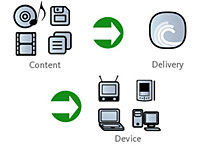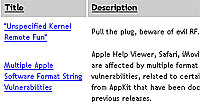Sony has just let it be know that it will be redesigning the internals for the EuropeanPS3, removing the Emotion Engine, which gives compatibility with PS2 games.
 The Emotion Engine will instead be handled in what they call, “a new combination of hardware and software emulation which will enable PS3 to be compatible with a broad range of original PlayStation (PS) titles and a limited range of PlayStation2 (PS2) titles.”
The Emotion Engine will instead be handled in what they call, “a new combination of hardware and software emulation which will enable PS3 to be compatible with a broad range of original PlayStation (PS) titles and a limited range of PlayStation2 (PS2) titles.”
Much fuss was made by Sony of the Emotion Engine when they were building up to the initial release of the first PlayStation. CNN even went as far as asking if the PS2 will replace the PC, with claims like, it was “two times faster than a 733-MHz Pentium III and 15 times faster than a 400-MHz Celeron at handling tasks like full-motion video.”
Now we know that Sony are keen to make the maximum amount of money reduce the amount of money that they are losing from selling PS3s. According to iSupply’s estimate on the Bill Of Material of the PS3, they’ll save $27 on this.
Many UK gamers were angered when they felt that they were paying over the odds for the UK PS3 when the price of £425 was made official. This news will do nothing to make them feel better.
The real danger is that if people think they’re going to get less of a machine that their-cousins in the US and Japan have, that may well be the last straw in deciding which ‘Next-Gen’ console they’ll buy – even if they never end up playing any of their old PS2 games.
Sony is on a knife-edge with this one. We’ve already postulated that the PS3 might not be bought in the way that was once thought, before the Wii caught peoples imaginations.
What is strange is that in an interview at the start of February, SCE UK managing director, Ray Maguire, said that the machines were being built at that point, but omitted to mention that they would be fundamentally different.
Full release follows …
23/02/2007 10:00
Sony Computer Entertainment Europe Announces Hardware Specification of PLAYSTATION®3 for Europe
London, 23 February 2007 – Sony Computer Entertainment Europe (SCEE) today announced that PLAYSTATION®3 (PS3™) to be launched in Europe, Middle East, Africa and Australasia on 23rd March 2007 would utilise a new hardware specification.
The European PS3 will feature the Cell Broadband Engine™, 60 GB hard disc drive, Blu-ray Disc player, built-in Wi-Fi connectivity, SIXAXIS™ wireless controller. It also embodies a new combination of hardware and software emulation which will enable PS3 to be compatible with a broad range of original PlayStation® (PS) titles and a limited range of PlayStation®2 (PS2) titles.
“PS3 is first and foremost a system that excels in playing games specifically designed to exploit the power and potential of the PS3 system,” said David Reeves, President of SCEE. “Games designed for PS3 offer incredible graphics quality, stunning gameplay and massively improved audio and video fidelity that is simply not achievable with PS and PS2 games. Rather than concentrate on PS2 backwards compatibility, in the future, company resources will be increasingly focused on developing new games and entertainment features exclusively for PS3, truly taking advantage of this exciting technology.”
 Some additional PS2 titles will become compatible on the PS3 system through regular downloadable firmware updates, which will be made available through the PLAYSTATION®Network, from http://www.playstation.com or via PS3 game discs, with the first update planned for the launch date of the 23rd March 2007.
Some additional PS2 titles will become compatible on the PS3 system through regular downloadable firmware updates, which will be made available through the PLAYSTATION®Network, from http://www.playstation.com or via PS3 game discs, with the first update planned for the launch date of the 23rd March 2007.
Users will be able to check whether their titles are compatible with PS3 at http://faq.eu.playstation.com/bc. This site will be available on 23rd March to meet launch day.
1. A device compatible with Linear PCM 7.1 Ch is required to output 7.1 ch audio, supported by Dolby TrueHD or a similar format, from the HDMI OUT connector.
2. This system does not support output from the DTS-HD 7.1 Ch. DTS-HD 7.1 Ch audio is output from a 5.1 or lower channel.
3. Usability of all storage media types is not guaranteed.
4. Certain PlayStation 2 format software titles may not perform properly on this system. Visit faq.eu.playstation.com/bc for the latest information regarding compatible titles
 Research firm Hitwise reported that online traffic to YouTube soared past rival US TV websites, with the site recording more visits than all the television network Web sites combined during the week of Feb. 3rd.
Research firm Hitwise reported that online traffic to YouTube soared past rival US TV websites, with the site recording more visits than all the television network Web sites combined during the week of Feb. 3rd. Hitwise researcher LeAnn Prescott, commented, “This is a landmark event in the changing face of web traffic and entertainment consumption, now that entertainment seekers are now more likely to go to YouTube than any other television network or gaming website.”
Hitwise researcher LeAnn Prescott, commented, “This is a landmark event in the changing face of web traffic and entertainment consumption, now that entertainment seekers are now more likely to go to YouTube than any other television network or gaming website.” Once the biggest, baddest, mean mo’fo name in the world of web piracy, BitTorrent is going legit today with the launch of a digital store backed by a string of big name content partners.
Once the biggest, baddest, mean mo’fo name in the world of web piracy, BitTorrent is going legit today with the launch of a digital store backed by a string of big name content partners.
 The Emotion Engine will instead be handled in what they call, “a new combination of hardware and software emulation which will enable PS3 to be compatible with a broad range of original PlayStation (PS) titles and a limited range of PlayStation2 (PS2) titles.”
The Emotion Engine will instead be handled in what they call, “a new combination of hardware and software emulation which will enable PS3 to be compatible with a broad range of original PlayStation (PS) titles and a limited range of PlayStation2 (PS2) titles.” Some additional PS2 titles will become compatible on the PS3 system through regular downloadable firmware updates, which will be made available through the PLAYSTATION®Network, from http://www.playstation.com or via PS3 game discs, with the first update planned for the launch date of the 23rd March 2007.
Some additional PS2 titles will become compatible on the PS3 system through regular downloadable firmware updates, which will be made available through the PLAYSTATION®Network, from http://www.playstation.com or via PS3 game discs, with the first update planned for the launch date of the 23rd March 2007. 2007 has started at quite a pace for DigiTV. We have seen unprecedented growth in usage traffic following the introduction of a new job search plugin from Job Centre Plus.
2007 has started at quite a pace for DigiTV. We have seen unprecedented growth in usage traffic following the introduction of a new job search plugin from Job Centre Plus. Joost is currently in beta, and it’s understood that the Viacom material will be available for the yet-undefined launch date of Joost. The financial terms of the deal were not disclosed.
Joost is currently in beta, and it’s understood that the Viacom material will be available for the yet-undefined launch date of Joost. The financial terms of the deal were not disclosed. Joost recently introduced a version of Joost to run on Apple’s Mac. Version 0.8.0.1 for Mac came out on Monday, following a brief period in Alpha test. They describe it as looking “very much like Joost for Windows, while behaving very much like a Mac application.” A growing number of Mac Beta testers are complaining that the software only works on Intel-based Macs.
Joost recently introduced a version of Joost to run on Apple’s Mac. Version 0.8.0.1 for Mac came out on Monday, following a brief period in Alpha test. They describe it as looking “very much like Joost for Windows, while behaving very much like a Mac application.” A growing number of Mac Beta testers are complaining that the software only works on Intel-based Macs. We’ve been bombarded by the smug, highly slapable face of the Mac bloke in Apple’s omnipresent advertising campaign telling us how incredibly secure Macs are, but an independent researcher begs to differ.
We’ve been bombarded by the smug, highly slapable face of the Mac bloke in Apple’s omnipresent advertising campaign telling us how incredibly secure Macs are, but an independent researcher begs to differ. Finisterre says he started the project in response to Apple owners’ blasé attitude to security, commenting, “Try calling any Apple store and ask any sales rep what you would do with regard to security, ask if there is anything you should have to worry about?
Finisterre says he started the project in response to Apple owners’ blasé attitude to security, commenting, “Try calling any Apple store and ask any sales rep what you would do with regard to security, ask if there is anything you should have to worry about? Claiming that Apple hadn’t been too interested in opening a dialogue about security matters, Finisterre said that things were now changing for the better.
Claiming that Apple hadn’t been too interested in opening a dialogue about security matters, Finisterre said that things were now changing for the better. Looking deeper, deeper, deeper into his shiny orb (oo-er), the beardy Cerf revealed that it won’t be personal computers fuelling the growth of the internet. Instead he reckons that the expansion of the worldwide web will be powered by mobile phones, with countries like India snapping up zillions of the fellas and getting online en masse.
Looking deeper, deeper, deeper into his shiny orb (oo-er), the beardy Cerf revealed that it won’t be personal computers fuelling the growth of the internet. Instead he reckons that the expansion of the worldwide web will be powered by mobile phones, with countries like India snapping up zillions of the fellas and getting online en masse. “The mobile phone has become an important factor in the Internet revolution,” he added.
“The mobile phone has become an important factor in the Internet revolution,” he added. Nikon has announced several additions to its new Coolpix lineup today, but the one that’s caught our eye is its high-end Coolpix P5000 prosumer model.
Nikon has announced several additions to its new Coolpix lineup today, but the one that’s caught our eye is its high-end Coolpix P5000 prosumer model. We like proper image stabilisation (rather than the ISO-booting sleight-of-hand touted by some makers) and the P5000 comes with optical lens shift VR (Vibration Reduction) technology borrowed from Nikon’s upmarket SLR camera systems.
We like proper image stabilisation (rather than the ISO-booting sleight-of-hand touted by some makers) and the P5000 comes with optical lens shift VR (Vibration Reduction) technology borrowed from Nikon’s upmarket SLR camera systems. In line with most of its rivals, the P500’s ISO range soars up into the grainy heights of ISO 3200 capability (at a reduced 5M capacity), with an Anti-Shake and High-Sensitivity mode automatically selecting the optimal rating.
In line with most of its rivals, the P500’s ISO range soars up into the grainy heights of ISO 3200 capability (at a reduced 5M capacity), with an Anti-Shake and High-Sensitivity mode automatically selecting the optimal rating. They’ll also enjoy the optical viewfinder, even if it is a bit of a squinty affair, with the rechargeable Lithium-ion battery EN-EL5 promising around 250 shots on a single charge. There’s a vaguely useful 21meg of internal memory with a SD card slot offering SDHC card compatibility.
They’ll also enjoy the optical viewfinder, even if it is a bit of a squinty affair, with the rechargeable Lithium-ion battery EN-EL5 promising around 250 shots on a single charge. There’s a vaguely useful 21meg of internal memory with a SD card slot offering SDHC card compatibility. Not all the kids are feeling the digital love though, with 45 per cent of respondents spending but ne’er a bean on music.
Not all the kids are feeling the digital love though, with 45 per cent of respondents spending but ne’er a bean on music. When it comes to the real big spenders, the lucrative 20-24 year olds sector were flashing the most cash, with two thirds spending up to £10 a month on downloads, and 16 per cent spend from £10 to £20 a month.
When it comes to the real big spenders, the lucrative 20-24 year olds sector were flashing the most cash, with two thirds spending up to £10 a month on downloads, and 16 per cent spend from £10 to £20 a month. After a lengthy sojourn in beta, Adobe has finally released version one of its Photoshop Lightroom photographic software
After a lengthy sojourn in beta, Adobe has finally released version one of its Photoshop Lightroom photographic software With more and more users shooting digitally and hard drives rapidly filling up with zillions of image files, there’s gold in them thar hills for software companies providing solid image management tools, and Adobe is hoping to nudge ahead of respected rivals like Portfolio,
With more and more users shooting digitally and hard drives rapidly filling up with zillions of image files, there’s gold in them thar hills for software companies providing solid image management tools, and Adobe is hoping to nudge ahead of respected rivals like Portfolio,  The new Key Metadata Browser comes with an improved ranking and rating system, sporting colour labels and a pick/reject system.
The new Key Metadata Browser comes with an improved ranking and rating system, sporting colour labels and a pick/reject system. Photoshop Lightroom runs under Mac OS X 10.4 or Windows XP (and, presumably) Windows Vista, and will be knocking out for an upmarket £125 (excl VAT) before April 30 rising to a hefty £175 (excl VAT) after that date.
Photoshop Lightroom runs under Mac OS X 10.4 or Windows XP (and, presumably) Windows Vista, and will be knocking out for an upmarket £125 (excl VAT) before April 30 rising to a hefty £175 (excl VAT) after that date.